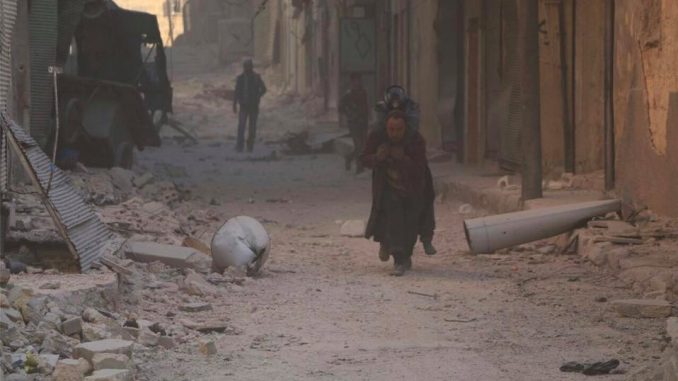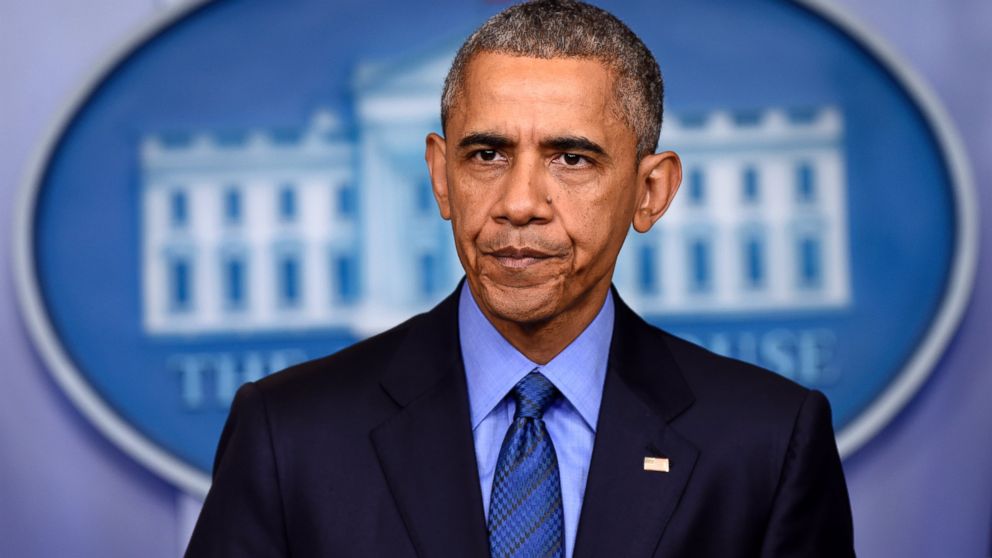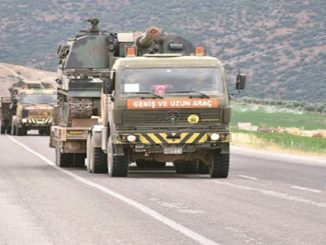
Assad regime forces’ fierce offensive cost the Syrian rebels all of the northern neighborhoods of their stronghold in east Aleppo on Monday, as thousands of civilians were displaced and stranded in the streets of the city hunted by death.
The Assad regime forces, backed by Russian air power, Iranian ground forces and Shi’ite militia fighters from Iran, Iraq, and Lebanon, has been tightening its grip on rebel-held districts of Aleppo this year.
They have gradually closed in on eastern Aleppo this year, first cutting the most direct lifeline to Turkey before fully encircling the east, and launching a major assault in September.
Assad regime forces started a major offensive to push opposition fighters out of the besieged eastern half of the city on 15 September.
Helicopters continue extensively dropping barrel bombs in conjunction with airstrikes by warplanes on areas in the eastern neighborhoods of the city, accompanied by artillery shelling by the regime forces in the same places.
The regime’s forces’ persistent and the intensive airstrikes forced the rebels to leave the areas they hold.
Assad regime said on 19 November that its forces captured the Dahiyet al-Assad district of western Aleppo , reversing all the gains made by rebels two weeks into their counter-attack against government-held areas.
Last week the army also captured the 1070 Apartments district and nearby hills in southwest Aleppo, a focal point of fighting for months and important because of its position alongside a corridor used by the government into the western zone.
Assad regime forces retook almost a third of the Masaken Hanano district, which has been held by the rebels for the past 4 years, on 22 November according to the observatory.
Masaken Hanano was the first Aleppo district to fall to rebels in 2012, and it is strategically vital.
On Saturday 26 November, Assad regime forces said in a statement they had, alongside their allies, taken full control over the Hanano housing district.
On Sunday, the 13th day of the operation, they also took control of the adjacent neighbourhoods of Jabal Badra and Baadeeen and captured three others, the Syrian Observatory for Human Rights said.
Inzarat, Al-Sakan al-Shaabi and Ain al-Tall have all returned to regime hands and government forces have made large forays into Sakhur and nearby Haidariya, the monitor said.
It said government forces are “in control of most of the northern part” of Aleppo.
Sunday ended amid heavy clashes between the opposition and forces loyal to President Bashar al-Assad in the strategic Sakhur district.
The next image shows how the situation was on Sunday
Syrian Army make rapid advances in #Aleppo.Captured Jabal Badro,part Sakhur district,Bostan Basha,Hellok,Inzarat &Haidariya Youth Housing pic.twitter.com/6NvI5MAUHY
— Military Advisor (@miladvisor) November 27, 2016
Losing the whole north-eastern parts of Aleppo
On Monday 28 November, government forces seized the Sakhur, Haydariya and Sheikh Khodr districts, and Kurdish fighters took the Sheikh Fares neighborhood from rebels, the Syrian Observatory for Human Rights monitor said.
Rebels have lost most of the northern neighborhoods in besieged east Aleppo, it added, as the army pushed an offensive to retake the whole of Syria’s second city.
“The rebels have lost control of all the neighborhoods in the north of east Aleppo, and this is their worst defeat since they seized half the city in 2012,” said Observatory director Rami Abdel Rahman.
Syrian state news agency SANA reported the capture of Haydariya and Sakhour as it looped footage showing some of the thousands of civilians who have fled east Aleppo in recent days as loyalist troops have advanced.
The Russian Defence Ministry said about 40 percent of the eastern part of the city had been “freed” from militants by Syrian government forces.
Russian President Vladimir Putin discussed the Syrian army’s advances with members of his Security Council on Monday, Russian news agencies quoted Kremlin spokesman Dmitry Peskov as saying.
East Aleppo-based journalist Zouhir al-Shimale told Al Jazeera that there was a “constant collapse” as rebel-held neighbourhoods continue to fall to government forces.
Officials with two Aleppo rebel groups said rebels had withdrawn to areas they could more easily defend, particularly after losing the Hanano housing complex area on Saturday.
“It is a withdrawal for the sake of being able to defend and reinforce the front lines,” an official in the Jabha Shamiya rebel group told Reuters.
Military situation in #Aleppo. #SAA & Allies gains from November 25 to November 28. pic.twitter.com/aYZ3o4SkwI
— Military Advisor (@miladvisor) November 28, 2016
NE part of #Aleppo city now under fully Syrian Army control after Sheikh Khader/&Fares have been captured.
HD:https://t.co/DaIHaOzXot pic.twitter.com/RW6Qhgkzv4— Military Advisor (@miladvisor) November 28, 2016
“Every day there are a lot of attacks, helicopters dropping barrel bombs and war planes dropping bunker-buster bombs and cluster munitions,” Modar Shekho, an emergency nurse in al-Shaar neighborhood, told Al Jazeera.
“The revolutionaries are fighting fiercely but the volume of bombardments and the intensity of the battles, the dead and the wounded, and the lack of hospitals, are all playing a role in the collapse of these frontlines,” said an official from Jabha Shamiya, one of the biggest groups fighting against Assad in northern Syria. Some of its members are fighting in Hanano.
He condemned the “international silence” and said the government and its allies were trying to exploit the period before the next U.S. administration took over.
“The Iranians, Russians and regime know there is a vacuum and they are trying to exploit it using all means,” he said. “We are in touch with the friendly states but unfortunately Aleppo is being left to be slaughtered.”
“The situation is very bad and the reason is the round the clock shelling with all types of weapons,” said Abdul Salam Abdul Razaq, military spokesman for the Nour al-Din al-Zinki group, one of the main Aleppo rebel factions.
“There is very fierce fighting going on now and the regime and its supporters are destroying whole areas to allow themselves to advance,” he told Reuters. Another fighter said there was heavy attrition in “people and ammunition”.
After 2000 Air raid, 7000 shells, 600 killed 2000 injured
Hospitals out of Service, @SyriaCivilDef declare #Aleppo devastation City pic.twitter.com/LSbWG2snSJ— Ahmad Alkhatib (@AhmadAlkhtiib) November 28, 2016
Latest stmnt from @SyriaCivilDef on situation in Aleppo. 2 of 4 White Helmet centers in besieged part of city destroyed, according to stmt pic.twitter.com/Gm0PabnxPH
— Megan Specia (@meganspecia) November 28, 2016
The news agencies reported the rebels’ loss from different perspectives.
civilians flee in thousands, sleep in the streets
Thousands of civilians left their homes fleeing the extreme bombardment and the clashes in the eastern parts of Aleppo.
“Yesterday was the worst day we’ve witnessed since the war started. More than 1,500 families have fled to the regime-controlled west of the city. The bombing is horrific,” Ibrahim Abu Leith, Aleppo-based spokesman for the Civil Defence said.
“The situation is disastrous,” added Ibrahim Abu Al-Leith.
“There is mass displacement and morale is in the gutter,” he said, his voice cracking with emotion.
“People are sleeping in the streets. They don’t have anything to eat or drink, but neither do we,” he told AFP.
Syria’s White Helmets warned on Monday they had no more fuel reserves for rescue vehicles.
In a video statement, the group urged “all humanitarian, aid, and medical organizations to immediately intervene to put an end to the humanitarian disaster” facing civilians in besieged Aleppo.
The people of #Aleppo will not forgive you for let them down, 10 civilians killed by #Assad air strike on #Alshaar neighborhood pic.twitter.com/8cdpdqVIxi
— Ahmad Alkhatib (@AhmadAlkhtiib) November 28, 2016
Evacuated Do you know what does it mean ?
I don't think you will never know #Aleppo, Civilians fleeing from Hanano To Shaar to Bustan Qasr pic.twitter.com/ez3OW1T7Zb— Ahmad Alkhatib (@AhmadAlkhtiib) November 28, 2016
Nearly 10,000 civilians have fled the east, the Observatory said late Sunday, with about 6,000 moving to the Kurdish-held Sheikh Maqsud neighborhood and 4,000 to government-held west Aleppo.
Kurdish officials published a video they said showed civilians crossing a field to Sheikh Maqsud, where local forces helped people cross a makeshift barrier.
Syria’s Kurds are officially aligned with neither the government nor the rebels, but the opposition views them as effectively allied with the regime in its efforts to recapture Aleppo.
Hundreds of civilians were also fleeing south to the remaining rebel-held districts with little more than the clothes they wore, an AFP correspondent said.
People in southern neighborhoods were donating blankets and other items to the new arrivals, who had travelled on foot, exhausted, cold and hungry.
The government assault of heavy air strikes, barrel bomb attacks and artillery fire has killed at least 247 civilians in east Aleppo, according to the Observatory.
However, the civil defence said that the deaths number exceeded 500 civilians, while more than 1700 were injured.
Hundreds of Civilians fleeing the clashes areas toward #YPG areas in Sheikh Maqsood after the #Assad forces advance in the east #Aleppo pic.twitter.com/6Hem2yJBQN
— Ahmad Alkhatib (@AhmadAlkhtiib) November 28, 2016
We have no home now. I got minor injury. I didn't sleep since yesterday, I am hungry. I want to live, I don't want to die. – Bana #Aleppo
— Bana Alabed (@AlabedBana) November 28, 2016
do you see me
I know you see me today and see a lot of us every day too
This gets 5 years and every day
And now #syria #Aleppo pic.twitter.com/knoliyZtQW— HASAN ALMOSSA. حسن (@hasanalmossa) November 28, 2016
@SyriaCivilDef Save one child and old man from under the rubble last day after #Assad air strikes pic.twitter.com/O9cnL9IlSH
— Ahmad Alkhatib (@AhmadAlkhtiib) November 28, 2016
What is next for Aleppo?
The holdout by the rebels in eastern Aleppo has served as a rallying cry for other rebel groups that have looked at their resistance as a sign that the Assad regime was vulnerable on the battlefield, and Aleppo became a new symbol for the Syrian revolution as the biggest rebel stronghold in Syria.
The Assad regime forces, backed by Russian air power, Iranian ground forces and Shi’ite militia fighters from Iran, Iraq, and Lebanon, has been tightening its grip on rebel-held districts of Aleppo this year.
They have gradually closed in on eastern Aleppo this year, first cutting the most direct lifeline to Turkey before fully encircling the east, and launching a major assault in September.
Rebels tried to break the siege two times, one in July and one in November but their attempts failed and the regime’s fierce offensive has cost them more than anyone has expected.
When the latest offensive started analysts feared that Assad regime might split rebel-held Aleppo in two, but today one-half of this region was lost.
Syria’s Al-Watan daily, which is close to the government, said the army was advancing quickly.
It said the next stage of the operation would be “to divide the remaining area into security districts that will be easily controlled and to capture them successively”.
The advance would then “push the gunmen to turn themselves [in] … or accept national reconciliation under the terms of the Syrian state”.
Capturing eastern Aleppo would be the biggest victory for Assad regime since the start of the revolution against him in 2011, restoring his control over the whole city apart from a Kurdish-held area that has not fought against him.
It would also be seen as a victory for his allies, Russia and Iran, which have outmaneuvered the West and Assad’s regional enemies through direct military intervention.
For Assad regime, taking back Aleppo would make its forces focus on ending the remaining rebels-held areas. These areas include the rebels’ stronghold in Idlib in addition to isolated areas in rural Damascus, Homs and Hama.
These areas have been under daily bombardment and crippling siege for years.
The Old city in Homs and parts of rural Damascus has already been lost to Assad regime, and the remaining areas are expected to follow.
As a conclusion, defeating the rebels and retrieving Aleppo means destroying the last major resistance stronghold of the Syrian rebels and will lead eventually to the victory of Assad regime and ending the Syrian revolution.



